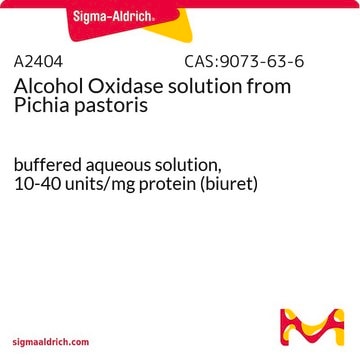Alle Fotos(2)
Wichtige Dokumente
F5152
D-Fructose-Dehydrogenase aus Gluconobacter industrius
lyophilized powder, 400-1,200 units/mg protein
Synonym(e):
D-Fructose:(acceptor) 5-oxidoreductase
Anmeldenzur Ansicht organisationsspezifischer und vertraglich vereinbarter Preise
Alle Fotos(2)
About This Item
CAS-Nummer:
MDL-Nummer:
UNSPSC-Code:
12352204
NACRES:
NA.54
Empfohlene Produkte
Form
lyophilized powder
Qualitätsniveau
Spezifische Aktivität
400-1,200 units/mg protein
Mol-Gew.
140 kDa
Zusammensetzung
Protein, ≤10% Lowry
Versandbedingung
wet ice
Lagertemp.
−20°C
Suchen Sie nach ähnlichen Produkten? Aufrufen Leitfaden zum Produktvergleich
Anwendung
D-fructose dehydrogenase is used as a biosensor to detect the presence of D-fructose.
Fructose dehydrogenase (FDH) is used in a number of basic research projects to examine the electrochemical properties of enzyme-catalyzed electrode reactions called bioelectrocatalysis. D-fructose dehydrogenase has been used in a study that contributed towards a convenient method for measuring rare sugars, monosaccharides, for applications in the bio-industry. A direct electron transfer reaction of d-fructose dehydrogenase adsorbed on a porous carbon electrode surface has been used to describe a batch-type coulometric d-fructose biosensor.
Biochem./physiol. Wirkung
D-fructose dehydrogenase catalyzes the oxidation of D-fructose to 5-keto-D-fructose.
Fructose dehydrogenase (FDH) is a heterotrimeric membrane-bound enzyme commonly seen in various Gluconobacter sp. especially in Gluconobacter japonicus (Gluconobacter industrius). It has a molecular mass of ca. 140 kDa, consisting of subunits I (67kDa), II (51 kDa), and III (20 kDa) and catalyzes the oxidation of D-fructose to produce 5-keto-D-fructose. The enzyme is a flavoprotein-cytochrome c complex with subunits I and II covalently bound to flavin adenine dinucleotide (FAD) and heme C as prosthetic groups, respectively.
Einheitendefinition
One unit will convert 1.0 μmole D-fructose to 5-ketofructose per min at pH 4.5 at 37 °C.
Physikalische Form
Lyophilized powder containing citrate-phosphate buffer salts, TRITON® X-100, and stabilizer
Lagerklassenschlüssel
11 - Combustible Solids
WGK
WGK 3
Flammpunkt (°F)
Not applicable
Flammpunkt (°C)
Not applicable
Persönliche Schutzausrüstung
Eyeshields, Gloves, type N95 (US)
Hier finden Sie alle aktuellen Versionen:
Besitzen Sie dieses Produkt bereits?
In der Dokumentenbibliothek finden Sie die Dokumentation zu den Produkten, die Sie kürzlich erworben haben.
Seiya Tsujimura et al.
Analytical chemistry, 81(22), 9383-9387 (2009-11-17)
This paper describes a batch-type coulometric d-fructose biosensor based on direct electron transfer reaction of d-fructose dehydrogenase (FDH) adsorbed on a porous carbon electrode surface. The adsorbed-FDH electrodes catalyzed the electrochemical two-electron oxidation of d-fructose to 5-keto-d-fructose without a mediator.
Ana Dominguez et al.
Revista iberoamericana de micologia, 23(3), 189-191 (2007-01-02)
Several microorganisms are reported to have transfructosylation activity due to fructosyltransferase and/or fructofuranosidase activities. However, the search for other fungi with higher transfructosylation activity remains a challenge. So, a presumptive and indirect colorimetric plate assay for the evaluation of transfructosylation
Takeo Miyake et al.
Journal of the American Chemical Society, 133(13), 5129-5134 (2011-03-12)
Nanostructured carbons have been widely used for fabricating enzyme-modified electrodes due to their large specific surface area. However, because they are random aggregates of particular or tubular nanocarbons, the postmodification of enzymes to their intrananospace is generally hard to control.
S Kadow et al.
Biotechnology and bioengineering, 91(2), 154-161 (2005-05-26)
A biosensor for fructose determination was used as basis of an assay for the determination of glucosyltransferase (GTF) activities and applied to monitoring recombinant enzyme production. GTFs catalyze the synthesis of glucans from sucrose leading to the release of fructose.
Xuee Wu et al.
Biosensors & bioelectronics, 25(2), 326-331 (2009-08-14)
The construction and characterization of a one-compartment fructose/air biological fuel cell (BFC) based on direct electron transfer is reported. The BFC employs bilirubin oxidase and d-fructose dehydrogenase adsorbed on a cellulose-multiwall carbon nanotube (MWCNT) matrix, reconstituted with an ionic liquid
Unser Team von Wissenschaftlern verfügt über Erfahrung in allen Forschungsbereichen einschließlich Life Science, Materialwissenschaften, chemischer Synthese, Chromatographie, Analytik und vielen mehr..
Setzen Sie sich mit dem technischen Dienst in Verbindung.






